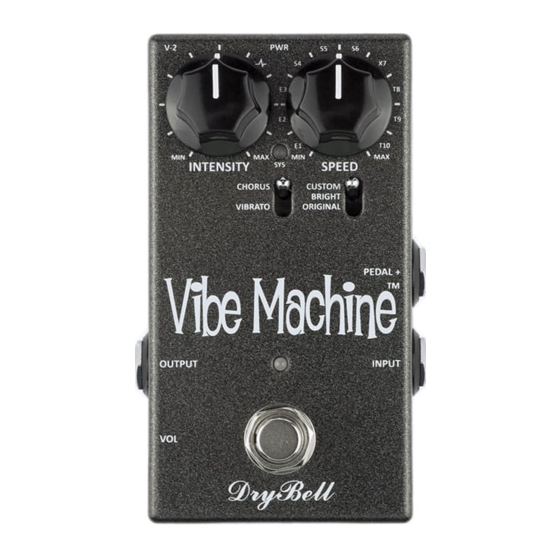DryBell Vibe Machine V-2 Optie Handboek - Pagina 12
Blader online of download pdf Optie Handboek voor {categorie_naam} DryBell Vibe Machine V-2. DryBell Vibe Machine V-2 18 pagina's.
Ook voor DryBell Vibe Machine V-2: Gebruikershandleiding (2 pagina's)

DryBell Guitar Effects
7 RESET TO DEFAULT FACTORY SETTINGS
There is a "Reset to Default Factory Settings" (RTDFS) function. After pressing the footswitch, VIBRATO/CHORUS
switch must be quickly toggled 10 times. Entering the RTDFS function is visually indicated by the system LED briefly going
OFF and then blinking ORANGE several times. It reverts all V-2 settings to default factory settings.
8 EXPRESSION PEDAL CALIBRATION PROCEDURE AND TIPS
In case your expression pedal doesn't have a full speed range from minimum to maximum speed you can calibrate the
Vibe Machine V-2 to work with a specific expression pedal. This is recommended before you first use your expression
pedal or if you are changing expression pedal model. The process for entering expression pedal speed calibrating mode
and calibrating the speed range is as follows:
Step 1: Connect an expression pedal to the Vibe Machine V-2, then connect or reconnect the power supply. Wait
until the V-2 system LED starts flashing orange.
Step 2: Quickly move the expression pedal from full up to full down several times until the system LED starts
flashing green.
Before it starts blinking green (which means the end of calibration process), the system LED will first blink red for
about 2 seconds which means that calibration process is in progress. The expression pedal has to be moved during the
whole time the LED is flashing orange and red. The end of the calibration procedure is indicated with the LED flashing
green.
After the calibration process the V-2 pedal always goes back to normal mode automatically and stays that way. You
can only enter the speed calibration mode within the first few seconds after the power supply is plugged in and if an
expression pedal is moved up and down several times (during those first few seconds after powering up). To re-enter
speed calibration mode you need to disconnect and re-connect the power supply again to restart the process. If you have
issues with calibrating your expression pedal, please check the short instructional videos on our YouTube channel (
During the calibration process it is very important to move your expression pedal fully up and fully down with the
force that you would usually use while playing, or slightly less. Some expression pedals have rubber stoppers that,
depending on the force used, can be pressed more or less during calibration. The calibration procedure will register the
end positions of the expression pedal including any pressure put on the rubber stoppers. Some expression pedals may have
a small amount of idle space at both ends of the rocker's travel, perhaps a millimeter travel where it might not effect
anything. Entering Reset to default factory settings function (RTDFS) will reset current calibration data stored in the
internal memory of the V-2 pedal back to default factory settings.
9 POWER SUPPLY CHECK FUNCTION AND POWER SUPPLY
RECOMENDATIONS
On powering up, the Vibe Machine V-2 can check if the power supply voltage is sufficient for proper operation. We
have embedded this function for many reasons and in response to feedback from V-1 users. The Vibe Machine has
relatively large power consumption because its incandescent lamp, and it needs a lot of energy from its power supply to
work properly.
Some V-1 customers had problems powering their Vibe Machine V-1 properly because their power supply was too
weak. One of the first problems that can manifest with insufficient power is that the pedal can have a weird heart beat or
noise and hum, all depending on type of power supply used. Also, if the power supply is too weak and other pedals (in
most cases any kind of gain pedal) are connected to the same daisy chain, the Vibe Machine's modulation rhythm can be
heard even if the Vibe Machine is off. That happens because pedal's incandescent lamp is pulsating, and the current that
goes through lamp is changing at the same rhythm as that of the modulation, so as a result the whole daisy chain voltage
starts pulsating due to insufficient power. If such pulsating voltage is powering another pedal at the same time, then that
other pedal can produce noise and hum at the same rhythm as the Vibe Machine's modulation. The character of the noise
depends on the type of pedal used alongside the Vibe Machine.
Similar problems occurred because users weren't aware of the Vibe Machine's power consumption. In most cases
the Vibe Machine was connected to a power supply that didn't provide sufficient current. To avoid that the Vibe Machine
BACK TO CONTENTS
www.drybell.com
DryBell
Vibe Machine V-2, Options User's manual, rev.1.4. 09/2018
Doc. No. DM0958/ Page 12
).
